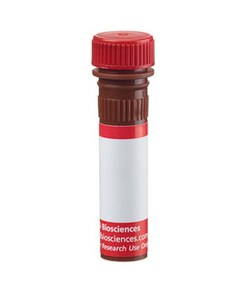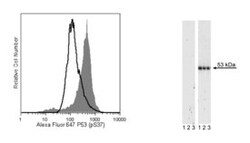Learn More
p53 (pS37) Mouse anti-Human, Alexa Fluor 647, Clone: J159-641.79, BD
Mouse Monoclonal Antibody
Supplier: BD Biosciences 560280
Description
The p53 protein is critical to regulation of normal cell growth and is a suppressor of tumor cell proliferation. Inactivation of p53 by a number of mechanisms, such as missense mutations or interaction with oncogenic viral or cellular proteins, can result in tumor progression. Mutations and/or allelic loss of the p53 gene are associated with a wide variety of human tumors. Known to have a role in transcriptional regulation, p53 suppresses various promoters containing TATA elements in an apparently sequence-independent fashion. p53 also binds to DNA in a sequence-specific manner via recognition of a 20-bp consensus-binding site. This interaction stimulates the expression of genes downstream
of the p53 binding site. A number of genes that contain p53-binding sites have been identified, including MDM2, GADD45, and muscle creatine kinase, which primarily prevent cell proliferation. MDM2 mediates feedback inhibition of p53, which is prevented by phosphorylations of p53 amino-terminal serines and threonines. Upon exposure to DNA damage-inducing agents, ATR and DNA-PK (ataxia telangiectasia- and Rad3-related and DNA-dependent protein kinases, respectively) phosphorylate p53 at serine 37 (S37). This
phosphorylation disrupts the binding of MDM2 to p53, allowing the cell stress responses to proceed. The J159-641.79 monoclonal antibody recognizes p53 phosphorylated at S37.
Host Species: Mouse
Clone: J159-641.79
Isotype: IgG1 κ
Species Reactivity: Human
Immunogen: Phosphorylated Human p53 Peptide
Intracellular Staining

Specifications
| p53 (pS37) | |
| Monoclonal | |
| Alexa Fluor 647 | |
| Aqueous buffered solution containing BSA and ≤0.09% sodium azide. | |
| Phosphorylated Human p53 Peptide | |
| 50 Tests | |
| Cell Biology | |
| Human | |
| IgG1 κ |
| Flow Cytometry | |
| J159-641.79 | |
| TP53 | |
| Mouse | |
| Affinity Purified | |
| RUO | |
| Primary | |
| Store undiluted at 4°C and protected from prolonged exposure to light. Do not freeze. |
Your input is important to us. Please complete this form to provide feedback related to the content on this product.


